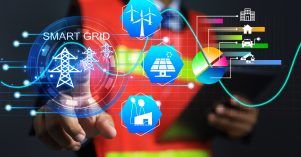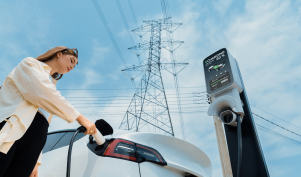
SIPL’s
Service Offering
for Edge-of-the-Grid Solutions
Behind the Meter Services
SIPL’s behind-the-meter services empower utilities and customers to efficiently monitor, manage, and optimize Distributed Energy Resources (DERs), like PV systems, batteries, and EV chargers. By leveraging advanced analytics and seamless integration, we enhance grid reliability, energy efficiency, and sustainability.
Gain insights into non-network DERs for optimized forecasting and performance tracking.
Remotely integrate and manage DERs using advanced protocols to support grid operations and demand response.
Utilize predictive analytics to reduce peak loads, optimize energy flows, and promote P2P exchanges.
Enable users to monitor energy usage and participate in grid programs via personalized dashboards.
Ensure adherence to global energy standards with robust reporting tools.
Flexible Energy Solutions
Empowering consumers to enhance grid stability with real-time demand management, dynamic pricing, and smart home integration solutions.
Demand Response Optimization
Targeted Energy Reduction
Implementation of advanced demand response programs to empower consumers to reduce or shift their electricity usage during peak periods, enhancing grid stability.

Dynamic Pricing Models
Develop and manage dynamic pricing models to incentivize customers for participating in demand response events.

Real-time Monitoring and Control
Utilize smart grid technologies such as OpenADR 2.0, SEP 2.0 and IoT to monitor and control demand response activities in real-time, ensuring compliance and maximizing efficiency.

Power Saver and BYOD Programs
Customer Engagement and Incentives
Development of tailored Bring-Your-Own-Device (BYOD) programs where customers can use their smart thermostats, PV inverters, and battery storage systems to participate in grid management.

Energy Usage Analytics
Provide consumers with detailed insights into their energy consumption patterns through load desegregation, helping them optimize their usage while benefiting from participation incentives.

Integration with Smart Home Systems
Seamlessly integrate BYOD programs with existing smart home ecosystems by developing inter-operability across the available home automation protocols such as ZigBee, Thread, SEP EE/HA, SunSpec, OCPP etc. to ensure smooth participation and enhanced user experience.

Peak Load Management Solutions
Predictive Load Forecasting
Leverage AI and machine learning to accurately forecast peak demand periods, enabling proactive load management and reducing strain on the grid.

Automated Load Control
Deploy automated control systems to manage and curtail peak loads through Utility DERMS/ANM system by sending active / reactive power set points, ensuring a balanced grid during high-demand periods.

Consumer and Commercial Programs
Develop tailored programs for both residential and commercial customers, encouraging them to contribute to peak load management through financial incentives and participation rewards.

Our VPP solution enables utilities to efficiently aggregate various DER resources (both network and non-network) to address demand-supply gaps and network constraints. Through diverse demand management programs, we enhance sustainability, grid resiliency, and encourage optimal participation from customer-end DER resources
- Aggregate and optimize distributed energy resources (DERs) using SEP 2.0 (IEEE 2030.5), OpenFMB 2.0, such as rooftop solar, wind turbines, and battery storage systems, to function as a single, flexible power plant.
- Provide real-time monitoring, control, and dispatch capabilities for these resources using Utility DERMS/ANM system for demand side management and improving grid stability and resilience.
- Enable participation in energy markets by selling excess power generated by DERs or providing ancillary services like frequency regulation, load balancing, and reserve power thr’ integrating Utility DERMS system with Transactive Energy Market hosted by a TSO/DSO.
- Implement automated trading platforms such as Regional Nomination Platform (RNP), Market Management System (MMS) etc. to maximize revenue opportunities by optimizing energy production and consumption based on market signals and grid needs.
- Offer scalable VPP solutions that can easily integrate new DERs as they come online, ensuring the system grows with the utility's needs and market dynamics through cloud enablement and enhanced inter-operability with industry open DER interface technologies.
- Customize VPP configurations to cater to specific utility requirements, including residential, commercial, and industrial sectors.
Optimize energy storage adoption with cost-effective, AI-driven solutions, ensuring grid resilience, regulatory compliance, and sustainable energy management.
- Operationalize Grid Scale Energy Storage systems that allow utilities to store excess energy during low-demand periods and dispatch it during peak times, reducing reliance on traditional generation methods.
- Developing flexible financing and leasing models to minimize upfront costs, allowing utilities to adopt energy storage without significant capital expenditure.
- Implement AI-driven energy management systems to optimize battery storage charge and discharge cycles based on demand and weather patterns, thereby extending battery lifespan and maximizing return on investment.
- Integrate energy storage with existing grid infrastructure, including EMS, ADMS, and DMS systems, to provide backup power during outages. This ensures uninterrupted service for critical customers and enhances overall grid resilience.
- Facilitating the alignment of energy storage solutions with environmental regulations to advance the utility’s sustainability goals through carbon modeling, measurement, and reporting solutions, thereby contributing to carbon reduction and the integration of renewable energy.
- Assist utilities in navigating regulatory frameworks to maximize incentives and benefits from energy storage investments.
Seamlessly connect EVs, chargers, and the grid with bi-directional charging, smart energy management, and user-friendly platforms to enhance grid stability and optimize e-mobility experiences.
Bi-Directional Charging Infrastructure
Deploy and manage bi-directional EVSEs using custom or COTS e-mobility platforms that support standard and fast charging, while also enabling participation in grid management through demand response.

Energy Management
Implement a smart home energy management system (EMS) that optimizes energy flows between EVSEs, the grid, and homes, maximizing self-consumption and revenue generation while balancing supply and demand in real-time.

Grid Support Services
Utilize EV batteries as distributed energy resources (DERs) to provide grid services such as frequency regulation, voltage support, and peak shaving.

E-Mobility Platform Design & Integration
Develop and integrate a centralized platform that connects EVs, chargers, and the grid on one side, with utility enterprise and third-party applications on the other, enabling seamless data exchange for monitoring and managing EV infrastructure for both EV users and grid operators.

User Experience Optimization
Design user-friendly interfaces for EV users, EV fleet operators, network charging station operators and utility managers, enabling easy access to charging data, payment systems, and energy management tools.

Interoperability
Ensure the platform supports a wide range of EV make/models, charger types (L1/L2/L3), and third-party energy management systems (EMS) to enhance flexibility and future-proofing.

SIPL seamlessly connect EVs, chargers, and the grid with bi-directional charging, smart energy management, and user-friendly platforms to enhance grid stability and optimize e-mobility experiences.
The Five-Minute Settlement (5MS) process from a utility perspective involves the frequent and precise reconciliation of energy transactions based on five-minute intervals. This process entails capturing and processing real-time data from advanced metering infrastructure, which tracks energy consumption and generation with high granularity. This frequent settlement interval supports better management of variable renewable energy sources and dynamic consumer behaviors, enhances pricing models, and fosters greater transparency in energy transactions.
Integrate AMI systems with Utility enterprise applications such as MDMS, CIS, Billing etc. using industry open standards IEC 62056 to collect and transmit data every five minutes, ensuring meter data acquisitor, data processing (VEE/billing determinants) and billing.
Implement solutions that integrate 5MS data with utilities IT-OT systems, for operationalizing business use cases around active network management (ANM).
Support the development of flexible pricing models that reflect real-time supply and demand across the market leading front office system (SAP ISU, Oracle EBS) and cloud bourn customer care and billing products (Powercloud, Ensek, Kraken), promoting energy conservation and cost savings.
Empowering communities with scalable platforms for renewable energy adoption, seamless utility integration, optimized revenue streams, and sustainable energy management, while ensuring regulatory compliance and flexibility for diverse community needs.
Platform Design & Implementation
Develop a robust, scalable platform tailored to the unique needs of community distributed generation, enabling seamless integration with existing utility systems such as DERMS, ADMS, EMS etc.

Community Engagement & Participation
Providing tools and strategies for utilities to engage with local communities, encouraging participation in CDG programs, and offering incentives for adopting renewable energy.

Revenue Stream Optimization
Enable utilities to monetize the energy generated by community participants through optimized billing, net metering, and selling excess energy back to the grid thr’ Community Energy Storage Initiatives.

Regulatory Compliance & Reporting
Ensure the CDG platform is compliant with local, state, and federal regulations, and provide automated reporting tools to meet regulatory requirements effortlessly.

Sustainability & Carbon Reduction
Support utilities in promoting sustainability goals by enabling communities to generate and use renewable energy locally, reducing their overall carbon footprint.

Integration with DER & Smart Grids
Ensure the CDG platform is compatible with distributed energy resources (DERs) and smart grid technologies through its inter-operability with DER interfacing technologies such as SEP 2.0, OpenADR 2.0 and OpenFMB 2.0, enabling dynamic energy management and load balancing.

Customization & Flexibility
Provide customizable solutions that can be tailored to the specific needs of different communities, whether urban, suburban, or rural.
